How to Make a Mind Map in PowerPoint

Mind mapping is a great idea to learn a series of concepts, ideas or information in a very visual way. Those mind maps are similar to hierarchical diagrams that have a series of branches. They need to be balanced, share the same ranking and must originate in the center. To divide the information into areas or fields, use different colors. It will help you visualize and learn ideas.
Mind maps are pretty useful in different contexts, as they help you synthesize, recall or analyze information. They can be key if you are developing a project or if you are a teacher, as you can use them with children. They are great for reviewing concepts!
Be a better thinker: in this post, we are going to teach you how to design a mind map in a PowerPoint template.
Planification
If you intend to create a mind map, it is because you want to transform a complex or monotonous piece of information into short, brain-friendly concepts. In our tutorial, we are going to create a mind map about astronomy, in which we are going to add some features about four planets.
It’s important to decide how many levels you want to include. Also remember to synthesise your ideas by means of keywords. For the sake of simplicity, our mind map will consist of a central idea and another level.
Central idea
Do you have a topic? Great. We have chosen features of planets, so this will be upper level in the hierarchy. All the other branches will relate to it.
- Open your PPT presentation and add a new slide. Here you’ll create the mind map. Click on New slide and choose a design.
- In the toolbar, click on Insert. In the Text section, click on Text Box.
- Click and drag to add the box. You want to establish a clear hierarchy, so make sure that you place it at the top of the slides.
- Write the concept and edit the format of your text using the Font tools. If you are still unsure of how to add text boxes or how to format texts, read our Slidesgo School tutorials.

Pro tip: to show adjustable drawing lines in your slide, click on View in the toolbar. Then, in Show features, mark Guides.
Branches
Now we need to ramify your idea. For our tutorial, we will create four different branches corresponding with 4 different planets, to wit: Mercury, Saturn, Mars and Venus.
- Decide the number of branches and their structure. Here, our branches consist of a square where we add the name of the planet plus a subtitle that explains their features
- PowerPoint allows you to create shapes. Simply click on Insert → Shapes → Rectangles.
- Click and drag to create the rectangle. If you want to style it, use Shape Fill, Shape Outline and Shape Effects in the toolbar.
- There needs to be a rectangle per branch. In order to duplicate the shape, click on it while pressing Ctrl (or ⌘ if you are using Mac) and place it.
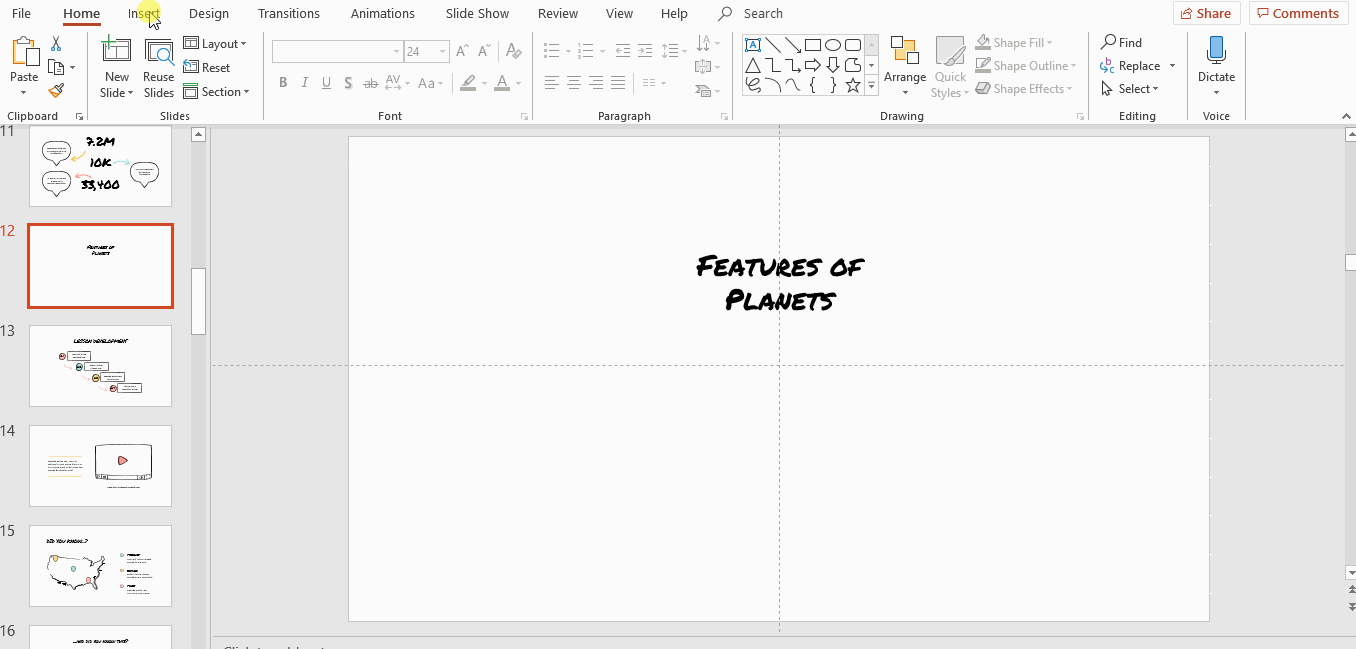
- You may want to explore other ways of creating nodes. All our templates include alternative icons and resources that you can use. They appear in the last slides, called alternative resources and icons.
- Go to any of those alternative resources slides and look for different shapes. Select the one you like pressing Ctrl+C to or ⌘+C in Mac copy it.
- Go to the mind map slide and copy the shape pressing Ctrl+V or ⌘+V in Mac. Move the shape clicking on it and dragging.
- To duplicate the rectangle, click on it while pressing Ctrl or ⌘ in Mac.
- If you want to change its style, click on Shape Fill, Shape Outline and Shape Effects in the toolbar. Remember to use the colors of the template!
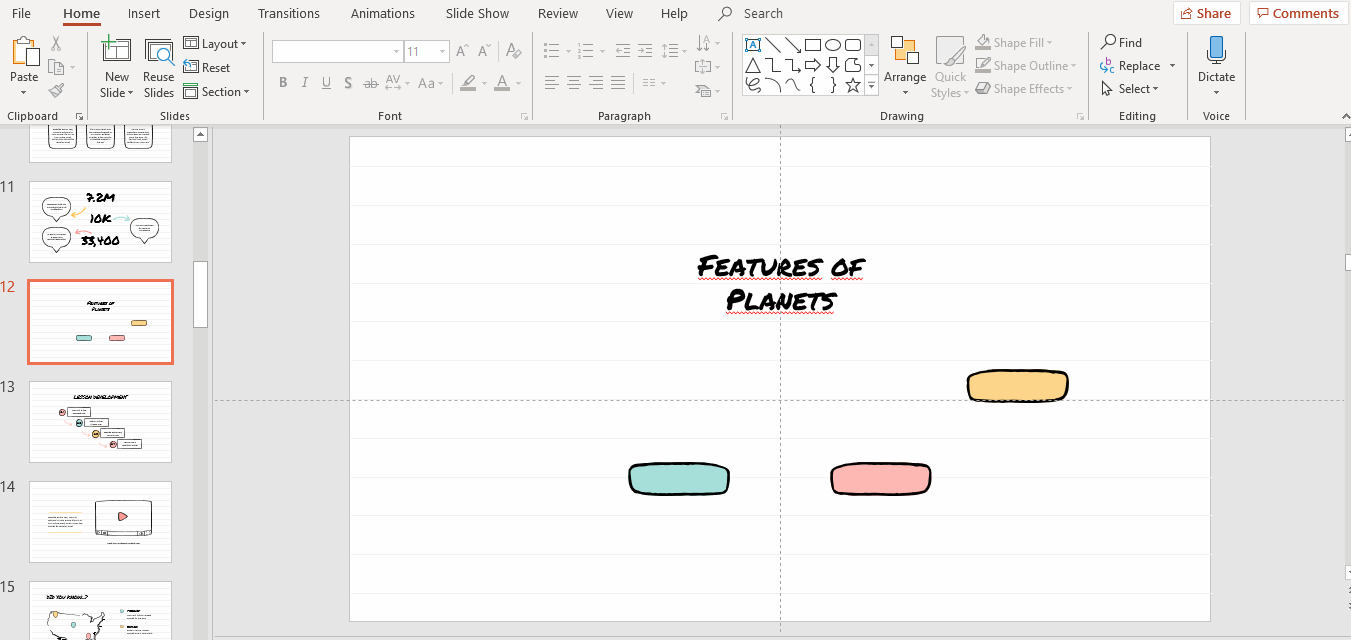
Pro tip: if you use different colors related to the concepts, it will be easier for you and for other people to establish a clear distinction between ideas and to retain information. For example: Mars can be depicted using red, the Earth using blue and so on.
- You have successfully added the rectangles, congratulations! Let’s add some keywords to them. Click on the shape twice and begin writing. Easy!
- In the toolbar you’ll find font tools to edit your text: Font, Size and other effects such as Bold or Italics. You can also align the text.
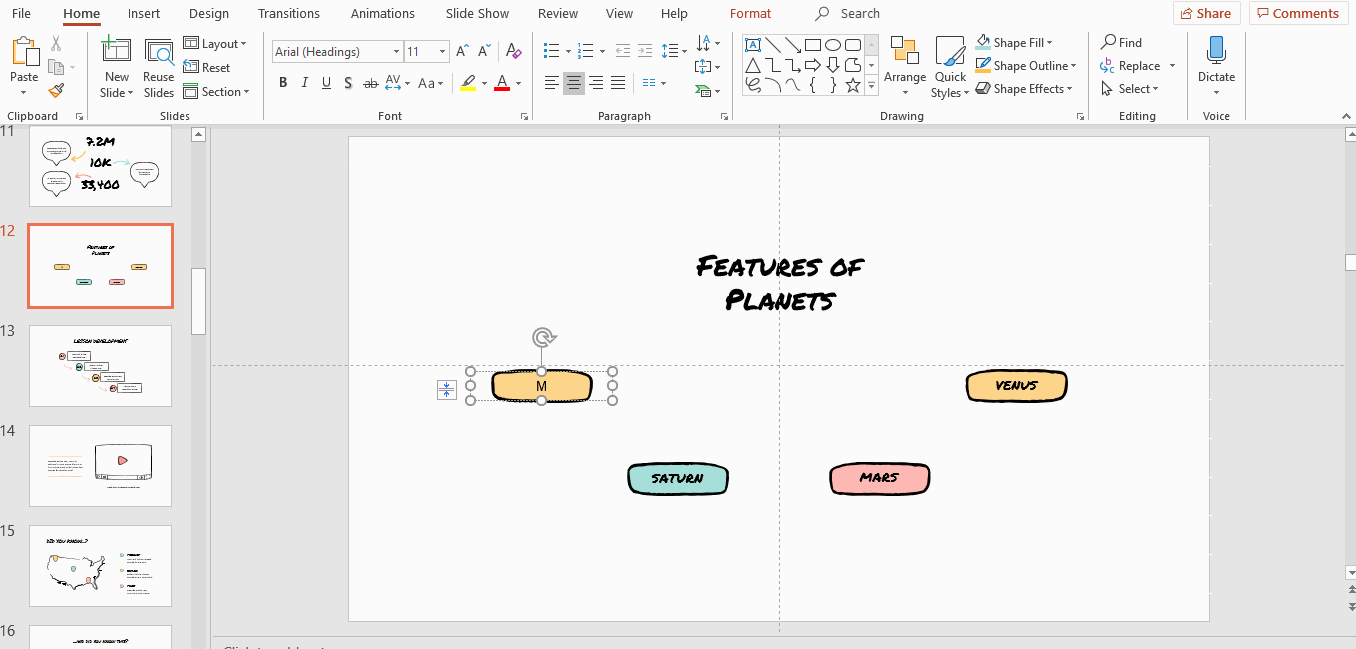
- You’ll need to add some extra pieces of information. For our mind map, we’ll add a feature per planet.
- To do so, add a text box under each rectangle. Remember to consult the tutorial about text boxes above and to edit the font accordingly.
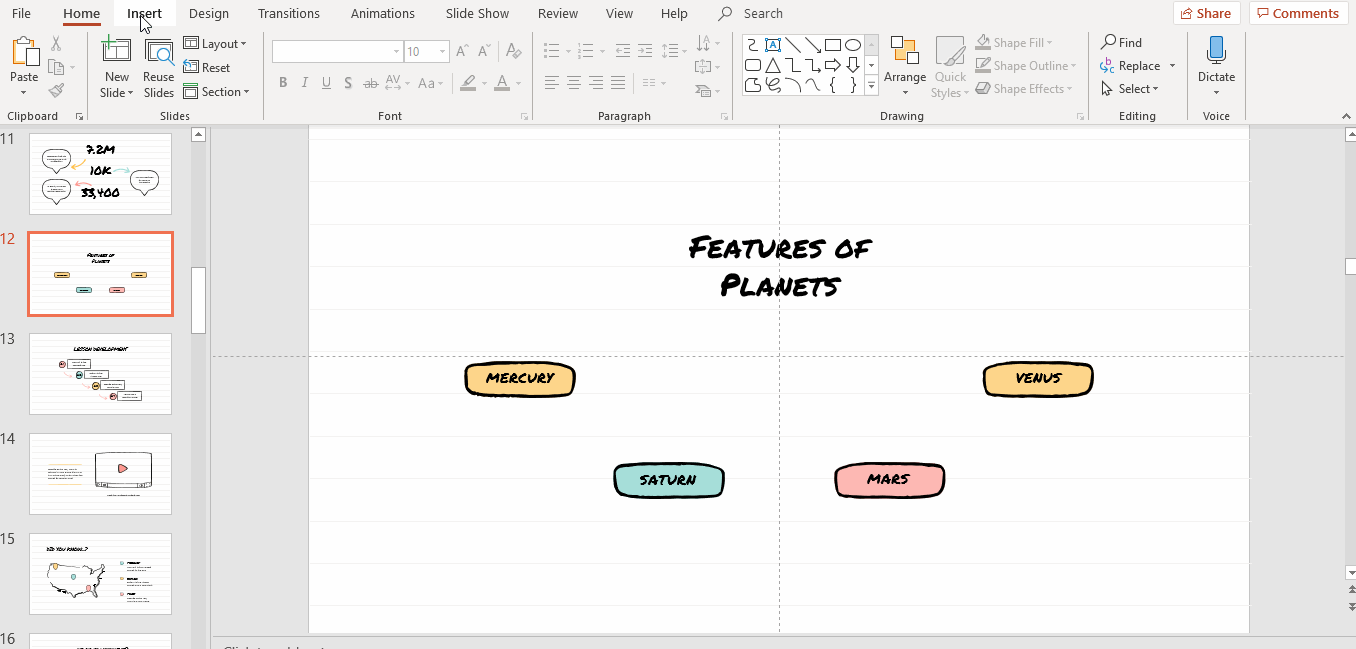
Perfect! The text step is to make a graphic connection between the branches and the main idea. We’ll also add some other elements to create a killing mind map.
Editing the style and adding icons in mind maps
You want to create a mesmerizing mind map, for sure. But you need to take into account adding a color code for your concepts, great fonts, icons or drawings and connectors. Let’s see how to finish your mind map:
- To make it visually appealing, we're going to insert a speech bubble above each keyword. In the toolbar, click on Insert → Shapes → Callouts. Select the one, click and draw to create it.
- As we have four branches, we need four speech bubbles. To duplicate a shape, click on it while pressing Ctrl (or ⌘ if you are using Mac). Modify their colors with the features Shape Fill, Shape Outline and Shape Effects in the toolbar.

Pro tip: if you keep Shift pressed while you make the shape bigger or smaller, it will keep its proportions.
- Did you like the design of the template illustrations? Then you could use one of the shapes included within our template. Go to the alternative resources slide, select the one, click on it and then press Ctrl+C or ⌘+C in Mac.
- Paste it in the mind map slide pressing Ctrl+V or ⌘+V in Mac to paste it. To duplicate it, click on it while pressing Ctrl or ⌘ in Mac. Change its color and style if necessary.
- If you want to rotate the shape, click on Arrange in the toolbar. Then, select Rotate and choose one of the options.
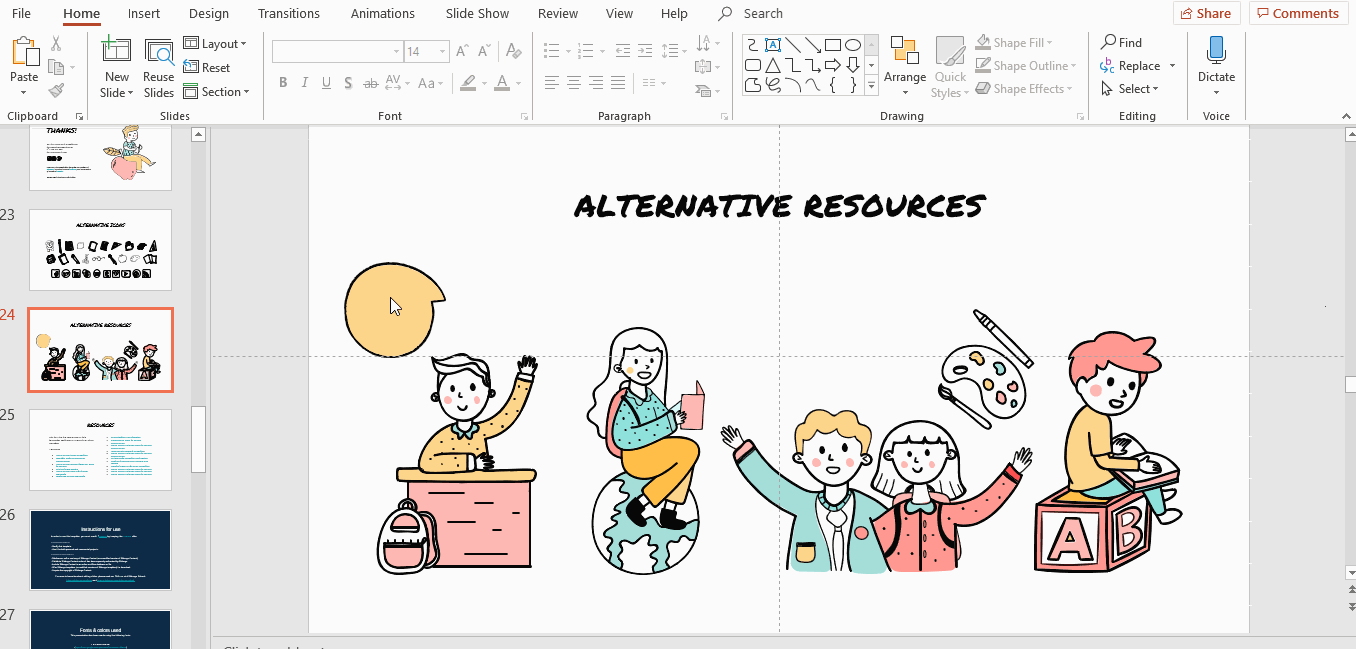
- Now let’s make the speech bubbles more visually appealing with some icons. It will allow you to make a connection between the keyword and the image. Go to the alternative icons slide and select one. Press Ctrl+C or ⌘+C in Mac to copy it.
- In the mind map, press Ctrl+V or ⌘+V in Mac and place the icon in the speech bubble. To know more about how to add and modify icons, you could read this tutorial.
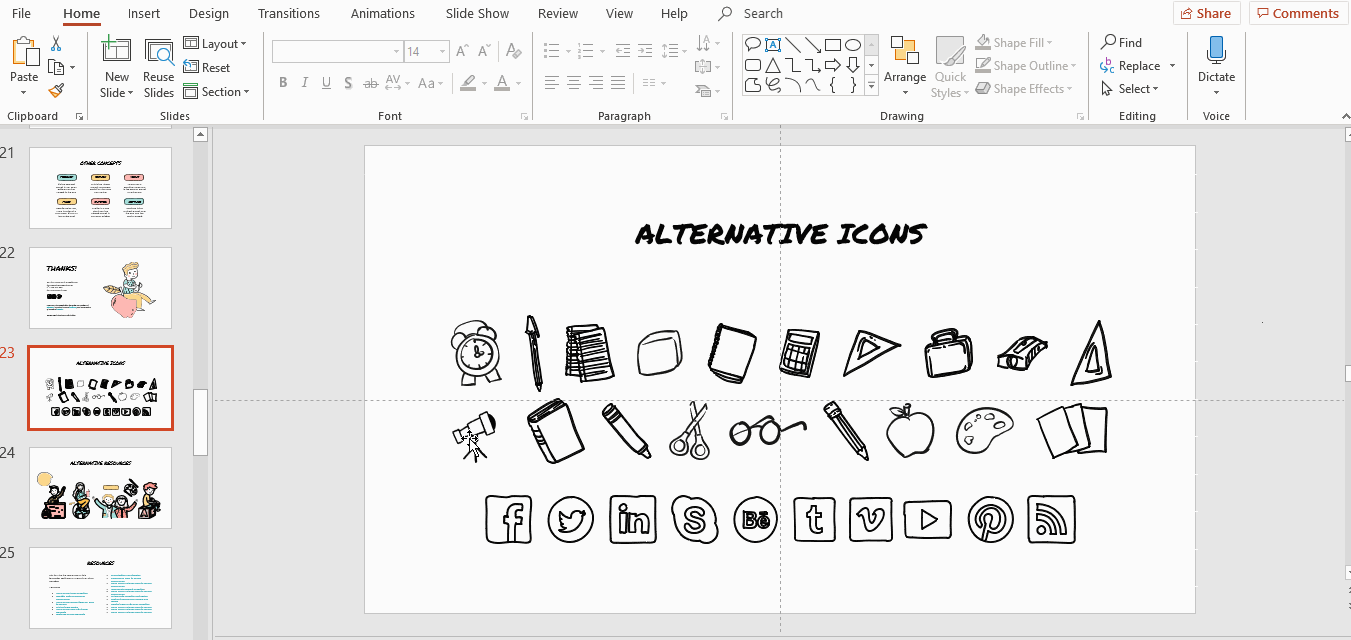
- The last step is to connect the branches with the central idea. Let’s add some arrows from the alternative resources slide. Copy one you like pressing Ctrl+C or ⌘+C in Mac.
- Press Ctrl+V or ⌘+V in Mac to paste it. To duplicate it, click on it while pressing Ctrl or Cmd, ⌘, in Mac.
- Change its colors and styles using Shape Fill, Shape Outline and Shape Effects in the toolbar.

- In case you prefer adding some of the lines or arrows offered by PowerPoint, click on Insert → Line if you want to add this sort of connector. Select one.
- Instead, if you prefer an arrow, click on Insert in the toolbar. Then click on Shapes → Block Arrows and click on one of them.
- Click close to the main idea and drag until the point in which you want the arrow or line to end.
- Click on Shape Outline to change the color. If you need another effect, choose Shape effects.
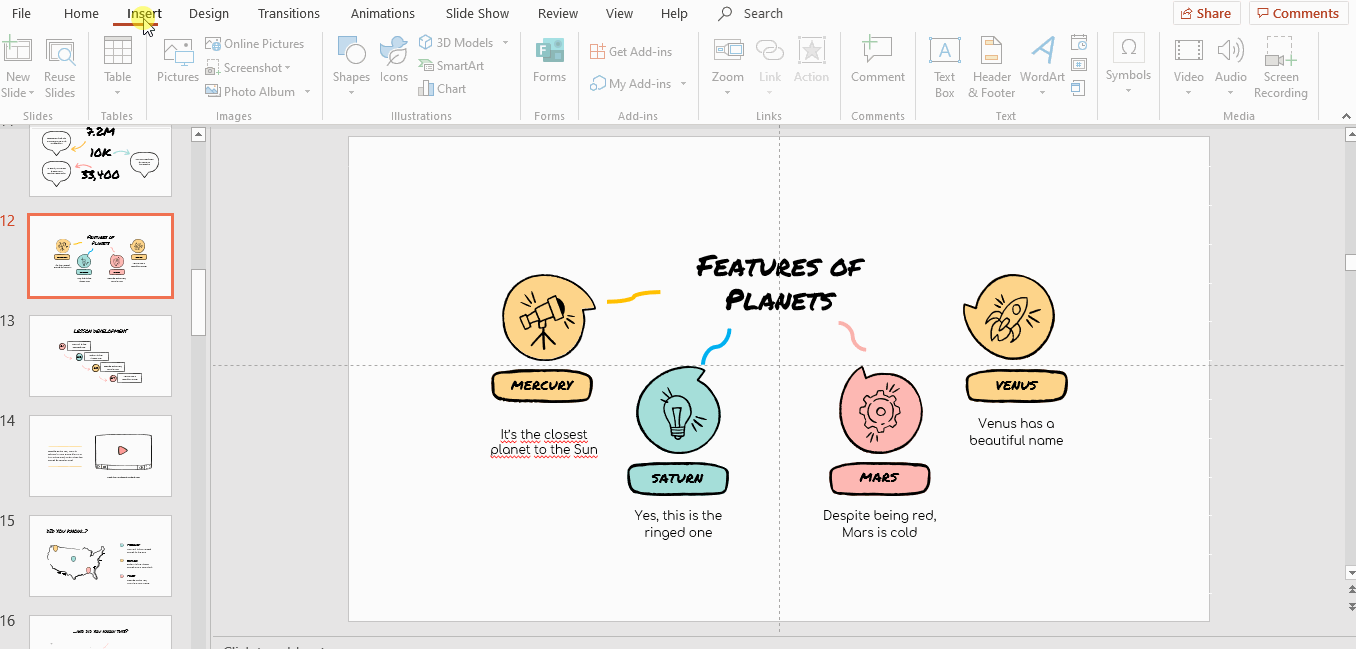
Pro tip: instead of choosing straight lines and arrows, use curved ones. They are brain-friendly!
Your mind map is ready! We have used the Sketchnotes Lesson theme for this tutorial, but you can get many other templates for free! Give them a shot!
Do you find this article useful?
Related tutorials

Creative PowerPoint Night Ideas
Want to be the star of your next PowerPoint Night? With the right ideas and a spark of creativity, you can turn any theme into a show-stopping experience that keeps everyone laughing and engaged. Whether you’re planning a friendly game night, a classroom challenge, or a team-building session, this guide is your secret weapon. Inside, you’ll find funny and clever PowerPoint night themes, ready-to-use templates,creating templates with AI Presentation Maker and expert tips to help you shine. Learn how to pick topics that surprise, design slides that wow, and deliver a presentation no one will forget. Ready to steal the spotlight? Let’s get started.

Smart Guide: Best AI Prompts for Powerful Presentations
Ever stared at a blank slide, knowing your message matters but not sure how to bring it to life? You’re not alone. With the rise of AI Presentation Maker, more creators, educators, and professionals are asking: What are the best AI prompts for presentations?This guide shows you exactly how to use smart prompts to unlock unique, story-driven slides — so you can spend less time designing and more time connecting with your audience. In this article, you’ll get actionable advice, real examples, and tips to avoid common mistakes, helping you creative an impressive presentation that truly stands out.

How Teachers Are Really Using AI in the Classroom: Voices from the Field
“I hope that AI can ensure students are still doing the planning, writing, and critical thinking needed. Students can't lose these skills.” -6th grade Science Teacher, FloridaFull disclosure: I interviewed my mom for this blog post.My mom, a retired 25+ year veteran educator who recently returned to the classroom, told me she felt overwhelmed by AI—and unsure where to start. If my mom, with decades of experience, felt lost in the AI wave, how many other educators are feeling the same?At Slidesgo, we want to support educators navigating the current tech landscape. So we talked to teachers across subjects and experience...

How to convert PDF to PPT online for free
Ever tried making a presentation from a PDF? It’s not exactly fun—copying, pasting, reformatting… plus, it takes forever. So, why do it? Instead convert your PDF to PPT in seconds through our new tool AI PDF to PPT converter.Whether you’re pitching an idea, designing tomorrow’s lesson plan, or presenting a report, this tool helps you focus on what matters—your content. Plus, with everything in PowerPoint, you can tweak layouts, add animations, and make your presentation stand out. Want to learn how to convert a PDF to PPT for free?
